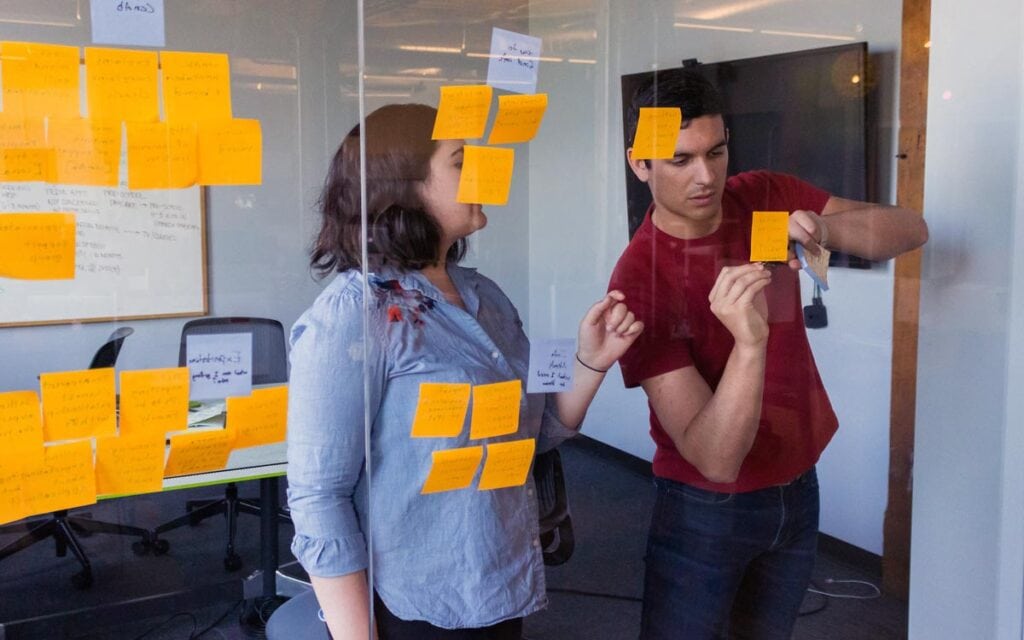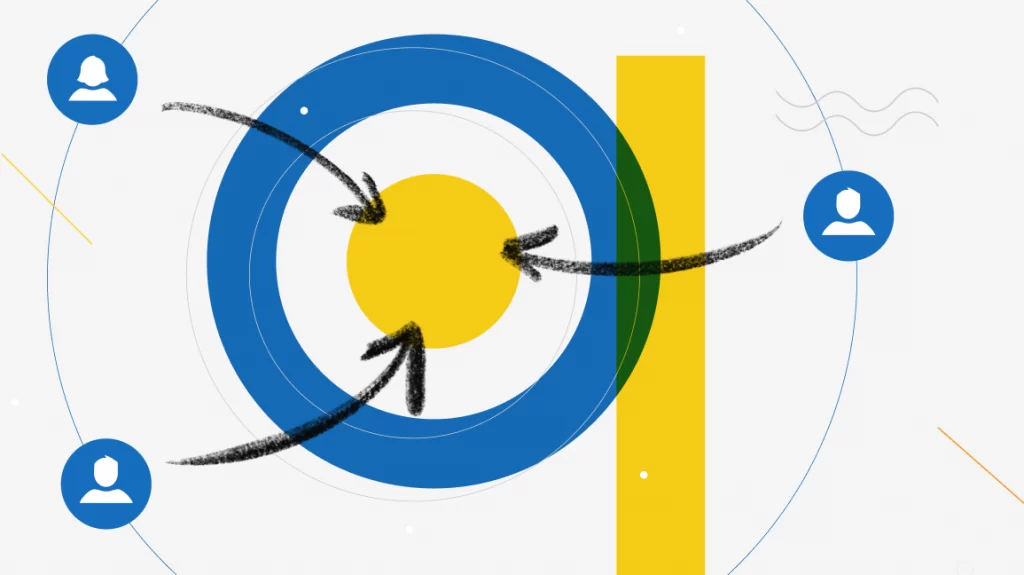The Components of a Web Development Team
Building a website or web application takes a coordinated effort from various professionals. At the core, the web development team is a cross-functional group that handles everything from planning and designing to building, testing and launching a digital product.
A web dev team brings people with complementary skill sets to meet project needs. The makeup of these teams can vary substantially depending on the undertaking's scope, complexity and budget. Yet most include a mix of the following roles:
Table of Contents
Project Manager

The project manager is the conductor of the web development orchestra, responsible for keeping everyone and everything on track and aligned towards the final goal. Key duties include:
Planning
- Working with stakeholders to define project scope, objectives and requirements
- Breaking down the project into manageable phases and sprint cycles
- Creating a resourced project schedule and detailed specifications
Coordinating
- Assembling the project team and assigning individual responsibilities
- Managing communications across all stakeholders and team members
- Securing any 3rd party vendors or contractors needed
Monitoring Progress
- Tracking work status and milestones through the development lifecycle
- Identifying potential delays or roadblocks to completion
- Making adjustments to timeline or resources as needed
Delivery
- Overseeing testing, fixes and final refinements during the launch phase
- Training content editors and site administrators as needed
- Transferring the site/app to the client for post-launch support
Skilled project management is indispensable for keeping web projects on time and within budget. The best project managers excel in organisation, communication and problem-solving.
Web Designer
Web designers focus on a website or application's aesthetics, layout and visual hierarchy. Their core contributions include:
User Research
- Gathering insights on target audience needs and behaviours
- Identifying user personas and scenarios to inform design decisions
Information Architecture
- Organising site content into logical, intuitive categories and flows
- Crafting navigation menus and taxonomies
Interface Design
- Producing creative direction on look-and-feel
- Developing page layouts, iconography and component libraries
Prototyping
- Creating wireframes, mockups and interactive prototypes to demonstrate proposed designs
Exceptional visual design is a lynchpin for usable and delightful user experiences. Skilled web designers marry form and function into cohesive designs centred on site visitors.
Front-End Web Developer
Front-end developers specialise in translating designs into functioning web interfaces using HTML, CSS and JavaScript. Typical duties include:
HTML Markup
- Authoring semantic, valid HTML pages as the foundation of the site
- Ensuring compliance with web standards and accessibility guidelines
CSS Implementation
- Writing CSS rules to control presentation across platforms/devices
- Creating reusable stylesheets for efficient site updates
JavaScript Programming
- Adding dynamic behaviors with JavaScript for interactivity
- Connecting to data sources to populate interfaces
Framework Integration
- Incorporating CSS/JavaScript frameworks like Bootstrap or React
- Implementing templating systems for maintainable code
The source code produced by front-end developers ultimately determines what site visitors see and engage with on the front end. Meticulous coding and testing are imperative for polished user experiences.
Back-End Web Developer
While front-end developers focus on the client side, back-end developers concentrate on server-side code to control behind-the-scenes behaviours and integrate external systems, including:
Server Configuration
- Installing and configuring web servers like Apache or Nginx
- Optimising performance for traffic volumes and distribution
Database Integration
- Connecting front-end interfaces to database engines like MySQL
- Writing API code to perform CRUD operations on data
Business Logic
- Crafting custom application logic to handle workflows and processes
- Processing forms, payments, notifications, analytics etc.
API Integration
- Building connections to 3rd party platforms and services
- Streaming in dynamic data like maps, media, etc.
Robust back-end programming lays the groundwork for functional, data-driven websites and apps with flexible customisation.
Quality Assurance (QA) Engineer

QA engineers perform systematic tests to catch defects before software reaches end users. Their regimen verifies:
Functionality
- Checking every user path and feature under simulated use cases
- Ensuring alignment with documented requirements
UI/UX Quality
- Testing ease of navigation, task completion and other ergonomic factors
- Flagging confusing interfaces or error messaging
Cross-browser Compatibility
- Comparing appearance and behaviour across target browsers
- Identifying rendering quirks needing fixes
Responsiveness
- Examining presentation on mobile vs. desktop breakpoints
- Catching layout or readability issues on smaller screens
Security
- Probing for vulnerabilities like SQL injections or XSS exploits
- Running tools to scan for malicious code injections
Delivering flawless software requires the meticulous, unbiased eyes of QA personnel. Their work safeguards both the product creators and end users.
DevOps Engineer
The DevOps engineer streamlines the entire process of continuously delivering high-quality software. Key activities include:
Infrastructure Automation
- Provisioning and configuring development/staging environments
- Scripting server and database deployment processes
Continuous Integration
- Establishing version control workflows and repositories
- Automating build, test and release management steps
Monitoring
- Instrumenting software with logging and alerts
- Tracking application health metrics and usage analytics
Cloud Architecture
- Designing hardware-agnostic infrastructure-as-code
- Leveraging scalable cloud platforms like AWS or Azure
DevOps enables more robust and agile software lifecycles by honing deployment routines for efficiency and reliability.
Extended Team Members
Larger web projects often demand even more contributors with specialised expertise, such as:
- Content Strategists – Planning site content architecture and copywriting
- SEO Analysts – Optimizing sites for search visibility
- Security Engineers – Conducting penetration tests and remediations
- Data Engineers – Building complex data pipelines and ML systems
- Product Managers – Defining business requirements and feature priorities
The exact team composition depends on balancing available skills against project goals. However, coordinated collaboration allows lean yet powerful groups to achieve ambitious web development outcomes.
Role Flexibility
The above descriptions define primary responsibilities, but individuals may juggle multiple duties depending on team size and structure. The core divisions of labour, however, remain:
| Role | Key Focus |
| Project Manager | Process & Oversight |
| Designer | User Experience |
| Front-End Developer | Client-Side Presentation & Interactivity |
| Back-End Developer | Server-Side Logic & Data Integration |
| QA Engineer | Testing & Bug Discovery |
| DevOps Engineer | Automation, Monitoring & Continuous Deployment |
By synchronising complementary specialities, web teams can execute complex digital projects spanning strategy, design and engineering. The following sections explore effective group dynamics for aligning all these components.
Cultivating an Agile yet Cohesive Web Team

Developing websites and applications with distributed skills and ownership requires thoughtful leadership and adaptable collaboration. The guiding philosophies of the Agile movement offer proven frameworks for smoothing web development coordination. Two of the most relevant tenets include:
Regular Communication
Open, ongoing conversations minimise work devolving into disconnected silos and keep all contributors marching towards shared objectives. Tactics like daily standups, active issue tracking, and collective code reviews maintain transparency. Such routines foster proactive problem-solving vs. reactive crisis management. They also help balance workloads and strengthen team camaraderie.
Iterative Delivery
Rather than work in isolation towards a big reveal, Agile teams favour building software in increments with regular feedback loops. Delivering working functionality early, even in primitive form, prevents deviations from core requirements. Short cycles also accommodate changing needs, allowing products to evolve iteratively versus following rigid plans. Such fluidity demands planning buffers but yields better results.
Web projects thrive when groups communicate early and often while embracing flexibility. Below are three formats for organising web teams to meet in the middle of structure and adaptability.
Three Models for Web Team Configuration
Dedicated Groups
At one end of the spectrum, some cross-functional web teams operate as a fixed unit across multiple projects. While members may have specialised skills, they share collective ownership for delivering software end-to-end.
Flexible Pools
Other companies assemble project-specific teams from an available talent pool. This model staffs initiatives based on skill demand while offering participants variation.
Outstaffing Hybrid
Organisations lacking specific competencies may build and augment core teams with contracted staff. This hybrid combines in-house domain expertise with on-demand speciality support.
Each approach has efficiency, morale and resource allocation advantages depending on organisational norms and constraints. Proactive communication and governance apply regardless to ensure coherency.
Facilitating Web Team Success
Beyond logistical configurations, specific cultural and operational elements set teams up for frictionless cooperation, including:
Convergent Vision & Priorities
- Strategic alignment across stakeholders on goals
- Consistent marching orders on objectives/timelines
Technical Acumen
- Conscious hiring for complementary skills
- Cross-training and documentation to protect knowledge
Healthy Working Relationships
- Camaraderie and empathy between personalities
- Conflict resolution and openness to feedback
Automated Processes
- Issue tracking, code reviews and testing to reduce bottlenecks
- Infrastructure automation enabling rapid provisioning
With a shared vision, compatible talent and nimble procedures, web teams unlock exponential productivity and innovation.
Key Milestones Across a Web Project Lifecycle

Successfully orchestrating people with diverse web development capabilities requires staged workstreams for gradual progress. Though every project follows a unique trajectory, most adhere to the following plan for structuring deliverables:
Product Discovery & Planning
Early on, producers collaborate with stakeholders to align on business objectives, target users, content needs and functional requirements critical for shaping the project charter.
Information Architecture (IA)
With requirements set, designers map out site content inventories, taxonomies and page templates conveying proposed IA.
Design Concepts
Creative visions are transforming IA blueprints into aesthetic direction with user flows, wireframes and visual mockups.
Technical Specifications
Engineering documents codifying exact component details, system integrations, data structures and other build specifications for developers.
Core Pages
Representative templates are built in functioning form to validate the technical approach before a broader rollout.
Minimum Viable Product (MVP)
A baseline working version with essential features is deployed early for stakeholder feedback to guide evolution.
Final Iterations
The remaining polish and enhancement work happens based on input until it is ready for full launch.
Post-launch Support
After going live, the team provides bug fixes, refinements and admin training during a transition period before handing off-site governance.
Not all initiatives require every stage, but web teams generally utilise stepped milestones to align skills, confirm direction, and add value incrementally en route to end-state solutions.
Team Communication Norms for Seamless Collaboration

Given web projects bring together diverse disciplines and handoffs between goals, streamlined team communications are imperative for productivity and innovation. Some best practices include:
Centralised Systems
Platforms like Jira, Asana, Trello or Notion provide one hub to manage tasks, document decisions and track progress.
Daily Standups
Short daily sync-ups within sub-teams foster coordination and transparency without overtaxing schedules.
Show & Tells
Demos of work in progress frequently circle back findings and surface complexities early before downstream impacts.
Retrospectives
Periodic project reviews diagnose pain points and spotlight areas for bolstering team cohesion.
Accessibility
Prompt notification and response expectations let teammates seek answers without delays.
With reliable centralised systems plus routine interactions via standups, demos and retrospectives, web teams gain continuous alignment while preventing surprises. Next, we explore more tactical team writing guidelines.
Crafting Team Writing Standards
When multiple authors collaborate on web content, inconsistent tone, terminology, and formatting can undermine experiences. Creating shared reference docs conveys expected styles. Helpful standards include:
Voice & Tone Guidelines
- Distinctive yet appropriate language reflective of brand identity and audience rapport
Grammar & Syntax Rules
- Standards for spelling, punctuation, capitalisation, numerals, etc. to unify writing.
Content Style Guide
- Formatting guidance on headings, lists, captions, citations and other structures.
Linking Conventions
- Rules for anchor text formulation, targets and contextual relevance.
Personalisation Parameters
- Instructions for addressing users and adapting experiences to roles, tasks, etc.
SEO Rules
- Mandates on metadata, URL patterns, alt text and search visibility considerations.
Error Messaging
- Standards for crafting user-friendly notices to minimise confusion.
Equipping contributors with concrete examples of desired editorial execution helps maintain tonal and structural consistency during drafting. Weighing specificity vs. flexibility finds the sweet spot between structure and creativity according to subject matter formality.
Let’s explore real-world examples of organisational models and team norms powering results for leading technology and media web teams.
Notable Examples of High-Performing Web Teams

GitLab Core Team Model
The all-remote software company GitLab utilises a structure of interdisciplinary Core Teams to build their tools and documentation sites. Group members split effort across assigned product areas versus siloed functions. Regular online meetings facilitate perspective sharing for consensus building. The coordinated model melds varied expertise into cohesive solutions.
New York Times Group Workflow
Specialised web producers, developers and editors cycle content through phased workflows at the NYTimes. Initial Digital Prototype groups launch experimental projects for testing before potential migration deeper into platforms like Cooking or Games. The system fosters editorial collaboration and technical standards.
Amazon Two-Pizza Rule
Amazon abides by the ‘two-pizza rule’, which caps team sizes at numbers small enough to be fed by a pair of pies. The mandate promotes more autonomous units versus sprawling groups relying heavily on management chains. Focused cooperation delivers faster progress.
While organisational structures differ by company stage, resources and priorities, the common ingredient for web team potency is cultivated collaboration through collective passion, tools and leadership, enabling individuals to thrive as a cohort.
Key Takeaways for Building a Strong Web Development Team
- Align skills to needs – Right-size groups and clearly define responsibilities based on project scope.
- Facilitate cohesion – Foster vision alignment, rapport, and process coordination.
- Communicate continuously – Overshare progress and obstacles to nip issues
- Work iteratively – Prioritize regular deliverables and feedback loops
- Automate extensively – Standardize routines for consistency and scale
- Allow flexibility – Accommodate emerging needs and improvements
With deliberate organisation schemes to sync cross-discipline contributions and processes encouraging fluid interactions, web development teams unlock exponential productivity and innovation scaling far beyond siloed efforts. They pool technical prowess with design insight and business savvy into cohesive solutions ready to delight users while achieving stakeholder aims. Even small but balanced crews can, thus, steer ambitious digital endeavours from vision to reality with agility and excellence.
Conclusion
Developing feature-rich, reliable and user-centred websites and applications demands expansive strategy, design and engineering skills. Web development teams fuse these diverse domain experts into cohesive units, which – when armed with methodical plans and nimble collaboration models – possess the rounded competencies to handle ambitious digital product creation from initial ideas to post-launch operations.
Through thoughtful work allocation, open communication norms and staged delivery milestones, these multidisciplinary crews morph isolated contributions into synchronised outcomes where the collective output exceeds the sum of individual efforts. The result is the harmony of technology and creativity, which yields delightful user experiences that further overarch business objectives. By continuing to foster human collaboration and software automation, leading web teams reshape what’s possible for digital products to inform, entertain and inspire online audiences everywhere.
Frequently Asked Questions
What are the leading roles on web teams?
Typical disciplines include project managers, designers, front-end developers, back-end developers, QA testers and DevOps engineers. Groups scale to assigned work complexity.
What project phases do web teams focus on?
While plans differ, common steps are product discovery, information architecture, design mockups, technical build-out, minimum viable product, final iterations, and post-launch activities.
How can web teams improve coordination?
Consistent online systems for documenting work and Agile rituals like daily standups, demos, and retrospectives promote transparency and cohesion.
Why standardise team writing guidelines?
Unifying formats and terminology across contributors maintain tonal, structural, and SEO consistency in experiences.
What team models enable web project success?
Options like dedicated squads, flexible talent pools or offshore augmentation have advantages based on needs and constraints.
